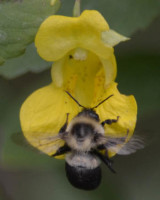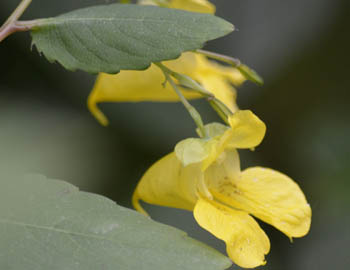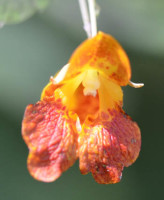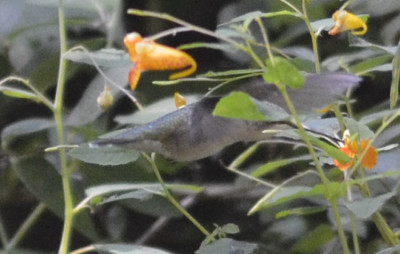Late this summer, on OutdoorOntario.Net some bird watchers were lamenting the loss of Jewelweed in a Toronto park. Apparently, a large field of it was a common place to take good photos of Ruby Throated Hummingbirds on their migration south. I was surprised to read this as I had no idea that hummers liked Jewelweed. In fact, I was a little skeptical—until yesterday when I saw a Ruby Throat feeding from the Jewelweed in the Rattray Marsh in Mississauga.

Sorry for the low quality photo!
Is Yellow Jewelweed the Same Type as the Orange Jewelweed?
In the fields and road edges of eastern Ontario where I grew up, the Jewelweed was a cheerful marigold orange in colour. So I was a bit surprised when I visited Riverwood Conservancy in Mississauga this September to find great banks of yellow Jewelweed in bloom.
Are the two colours the blossoms of two different species? Or does the flower just come in various shades, perhaps influenced by nutrients or the pH of the soil?
It turns out they are different species although both are native to North America. According to the Peterson’s Field Guide to Wildflowers, the yellow version is called Pale Touch-Me-Not or Jewelweed, Impatiens pallida.
The orange one is Spotted Touch-Me-Not or Jewelweed, Impatiens capensis. (Yes, it is a distant relative of the Impatiens we grow as an annual bedding plant.)
Touch-Me-Not Says the Jewelweed
Actually there’s no harm done if you touch Jewelweed. The common name refers to the seed pods. If you touch those, they explosively launch the seeds. Fun but harmless.
Do Hummingbirds Really Feed from Jewelweed?
Well, it depends. Hummingbirds do like to feed from the orange-coloured Spotted Jewelweed. In fact the shape of the flowers perfectly suits hummers. According to The Audubon Field Guide to North American Wildflowers Spotted Jewelweed “is especially adapted to hummingbird visitation, but bees and butterflies are also important pollinators.”
According to Wikipedia, admittedly not my favourite source, the shape of the flowers of the Pale (yellow) Jewelweed doesn’t suit hummingbirds. Most of the pollination of the yellow type is done by bees. The Missouri Department of Conservation agrees.
 More proof bees like Pale Jewelweed!
More proof bees like Pale Jewelweed!
I can personally vouch for the Ruby Throated Hummingbirds feeding from Jewelweed, now that I’ve seen it. I’m including a couple of the terrible photos as “proof.”
The photos are poor for a few reasons:
(a) I’m not a great photographer;
(b) I had a close-up lens on the camera just when the hummingbird appeared which
(c) I didn’t have time to change the lens before it left because a group of joggers approached from the other direction; and
(d) Jewelweed grows well in the shade and it was fairly dark where this bird was feeding.
Keep Your Eyes Out for Flying Jewels
So the next time you pass a drift of blooming orange Spotted Jewelweed, be sure to scan it for unexpected motion. You may just spot a glittering hummingbird busily feeding!
Related Reading
- Is This a Juvenile Male Ruby Throated Hummingbird or a Female?
- Pros and Cons of the book: Hummingbirds and Butterflies
Join In
Have you seen any Hummingbirds this year? Please share your experiences with a comment.




